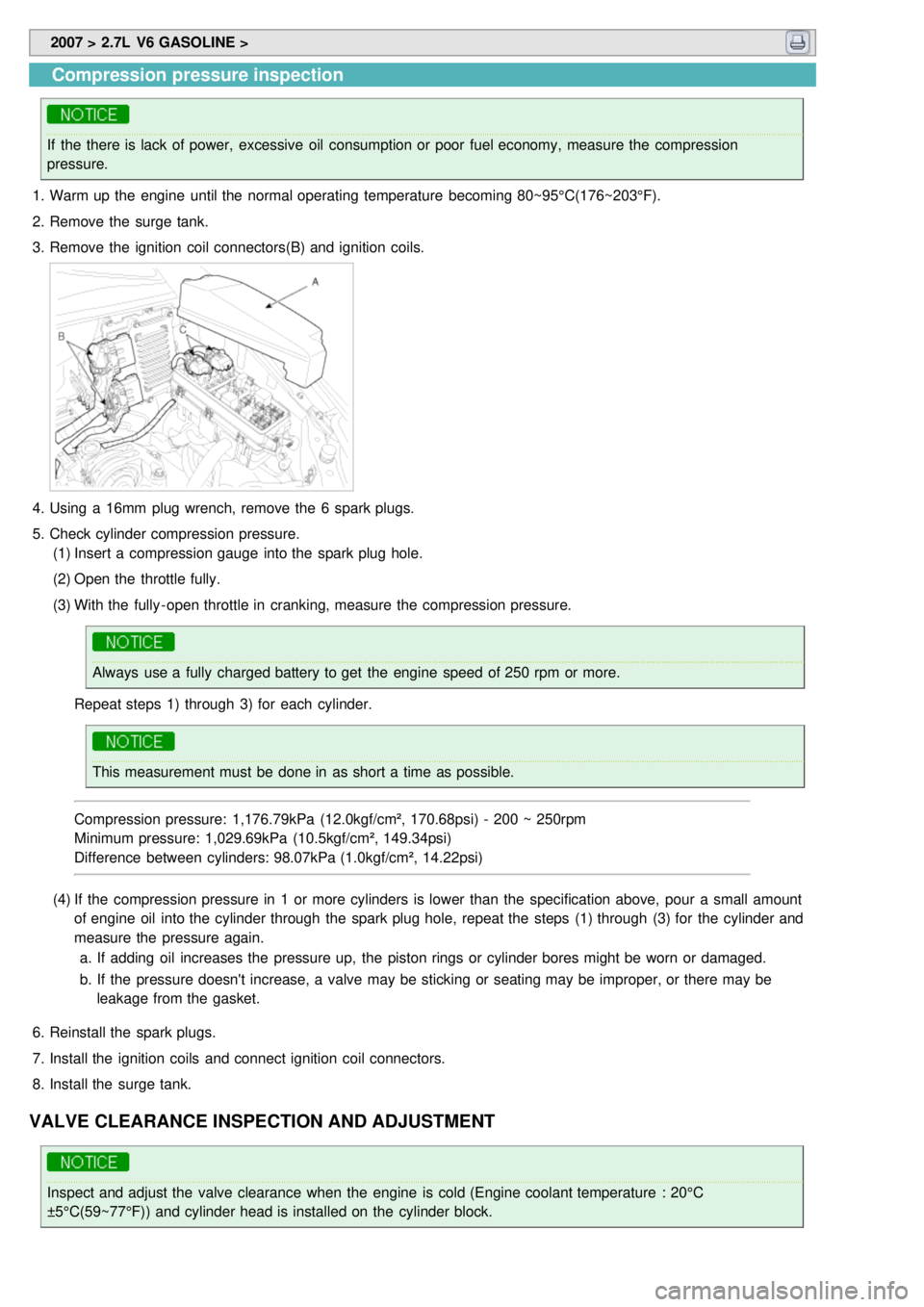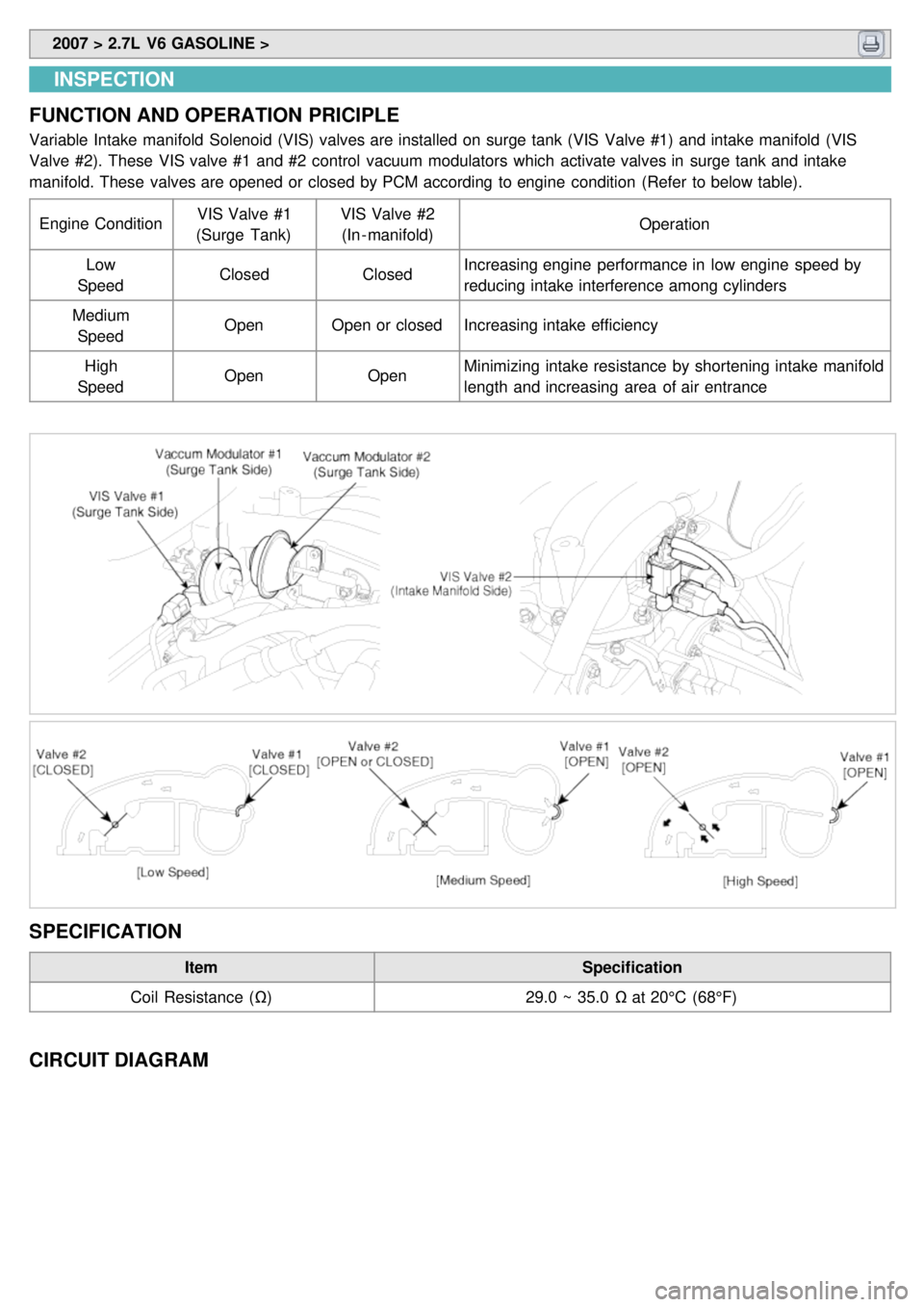open gas tank KIA CARNIVAL 2007 Workshop Manual
[x] Cancel search | Manufacturer: KIA, Model Year: 2007, Model line: CARNIVAL, Model: KIA CARNIVAL 2007Pages: 1575, PDF Size: 44.86 MB
Page 12 of 1575

2007 > 2.7L V6 GASOLINE >
Compression pressure inspection
If the there is lack of power, excessive oil consumption or poor fuel economy, measure the compression
pressure.
1. Warm up the engine until the normal operating temperature becoming 80~95°C(176~203°F).
2. Remove the surge tank.
3. Remove the ignition coil connectors(B) and ignition coils.
4.Using a 16mm plug wrench, remove the 6 spark plugs.
5. Check cylinder compression pressure.
(1) Insert a compression gauge into the spark plug hole.
(2) Open the throttle fully.
(3) With the fully - open throttle in cranking, measure the compression pressure.
Always use a fully charged battery to get the engine speed of 250 rpm or more.
Repeat steps 1) through 3) for each cylinder.
This measurement must be done in as short a time as possible.
Compression pressure: 1,176.79kPa (12.0kgf/cm², 170.68psi) - 200 ~ 250rpm
Minimum pressure: 1,029.69kPa (10.5kgf/cm², 149.34psi)
Difference between cylinders: 98.07kPa (1.0kgf/cm², 14.22psi)
(4) If the compression pressure in 1 or more cylinders is lower than the specification above, pour a small amount
of engine oil into the cylinder through the spark plug hole, repeat the steps (1) through (3) for the cylinder and
measure the pressure again.
a. If adding oil increases the pressure up, the piston rings or cylinder bores might be worn or damaged.
b. If the pressure doesn't increase, a valve may be sticking or seating may be improper, or there may be
leakage from the gasket.
6. Reinstall the spark plugs.
7. Install the ignition coils and connect ignition coil connectors.
8. Install the surge tank.
VALVE CLEARANCE INSPECTION AND ADJUSTMENT
Inspect and adjust the valve clearance when the engine is cold (Engine coolant temperature : 20°C
±5°C(59~77°F)) and cylinder head is installed on the cylinder block.
Page 210 of 1575

2007 > 2.7L V6 GASOLINE >
INSPECTION
When disconnecting the vacuum hose, make an identification mark on it so that it can be reconnected to its
original position.
1. Disconnect the vacuum hose from the solenoid valve.
2. Detach the harness connector.
3. Connect a vacuum pump to the nipple which is connected to intake manifold.
4. Apply vacuum and check when voltage is applied to the PCSV and when the voltage is discontinued.
Battery voltage Normal condition
When applied Vacuum is released
When discontinued Vacuum is maintained
5. Measure the resistance between the terminals of the solenoid valve.
PCSV coil resistance(Ω) :
14.0 ~ 18.0Ω at 20°C (68°F)
INSPECTION
FUNCTION AND OPERATION PRICIPLE
Purge Control Solenoid Valve (PCSV) is installed on the surge tank and controls the passage between the canister
and the intake manifold. It is a solenoid valve and is open when the PCM grounds the valve control line. When the
passage is open (PCSV ON), fuel vapors stored in the canister is transferred to the intake manifold.
SPECIFICATION
Item Specification
Coil Resistance (Ω) 14.0 ~ 18.0Ω at 20°C (68°F)
CIRCUIT DIAGRAM
Page 306 of 1575

2007 > 2.7L V6 GASOLINE >
INSPECTION
FUNCTION AND OPERATION PRICIPLE
Variable Intake manifold Solenoid (VIS) valves are installed on surge tank (VIS Valve #1) and intake manifold (VIS
Valve #2). These VIS valve #1 and #2 control vacuum modulators which activate valves in surge tank and intake
manifold. These valves are opened or closed by PCM according to engine condition (Refer to below table).
Engine Condition VIS Valve #1
(Surge Tank) VIS Valve #2
(In - manifold) Operation
Low
Speed Closed
ClosedIncreasing engine performance in low engine speed by
reducing intake interference among cylinders
Medium Speed Open
Open or closed Increasing intake efficiency
High
Speed Open
OpenMinimizing intake resistance by shortening intake manifold
length and increasing area of air entrance
SPECIFICATION
Item
Specification
Coil Resistance (Ω) 29.0 ~ 35.0 Ω at 20°C (68°F)
CIRCUIT DIAGRAM